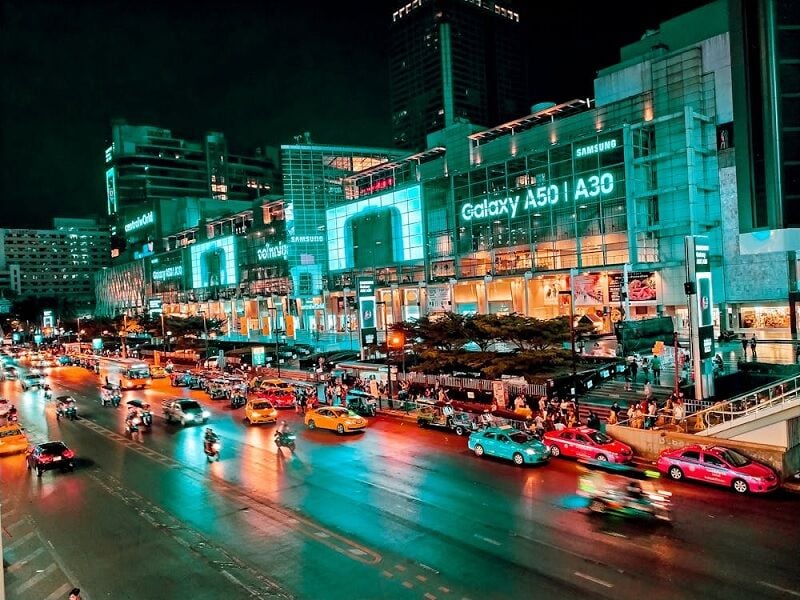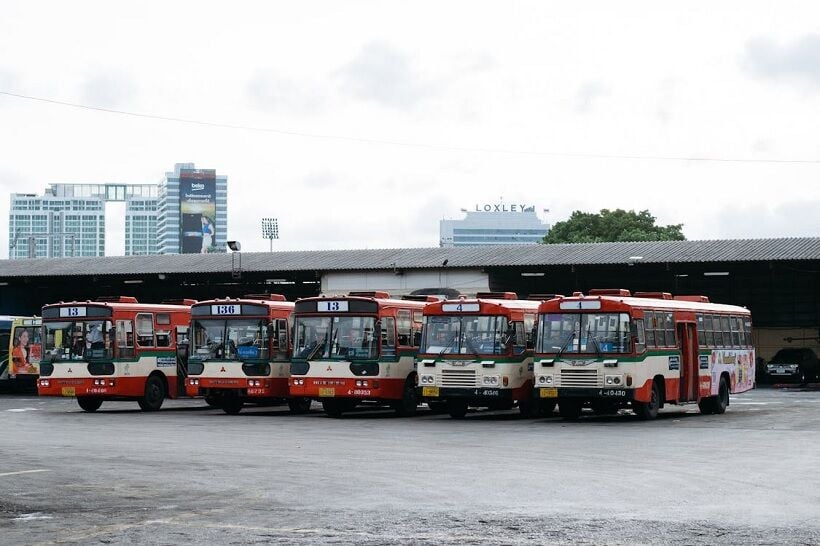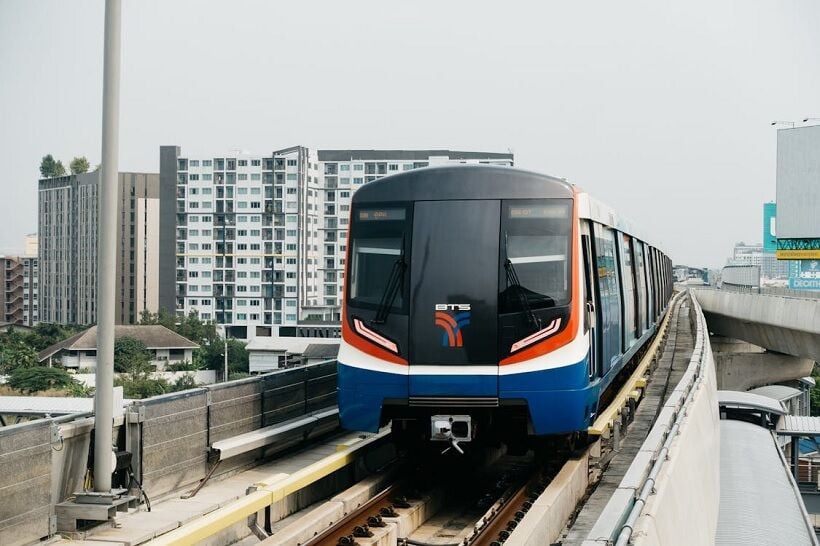Travellers guide to all transportation in Thailand

Discovering the lively streets and serene landscapes of Thailand is sure to be on your bucket list but, like any journey, it has its challenges. Choosing among the abundant transportation options in Thailand can become quite a daunting task. In this guide, we will simplify the different options available to you.
Traditional yet unconventional, tuk-tuks comprise a mighty part of the transportation scene in Thailand. They’re designed as three-wheeled vehicles with a small cabin for the driver in the front and a bench seating area for passengers in the back. They comfortably accommodate 2 to 3 occupants on brief journeys. In Bangkok, tuk-tuks are compact and nimble, ideal for short trips across the city. In recent years, their popularity has grown in parallel with the influx of tourism and many tourists opt for tuk-tuk tours as a memorable way to explore the city.
As for fares, they oscillate between 80 and 150 Baht, depending on the distance and location. Despite a lack of set fares, bargaining forms an integral part, giving you an edge while commuting.
Thaiger’s tips for riding Tuk-tuks:
-
- Bargain with the driver, and settle the fare before you hop on.
- Stay alert due to possible scams, and always protect your belongings.
Motorbike taxis
Colloquially known as ‘win’ or ‘motosai,’ Thai urban transportation is incomplete without acknowledging the notorious motorbike taxis. These hired riders ferry passengers across for short travel needs, at fares negotiable, akin to Tuk Tuks.
They can be found on just about any corner around town, often in a cluster of drivers who operate within their designated areas. They are hard to miss, just look out for the distinct orange vests. They typically ride around on scooters, cutting through traffic seamlessly while carrying one or two passengers at a time.
Rides are generally short, averaging around a few kilometres but fares reflect the distance travelled and can get up to 200 baht. Be sure to confirm the price before the ride so that you are not overcharged.
Also, remember to wear helmets and hold on tightly as your rider is navigating through traffic to avoid injuries in the rare case of an accident.
Thaiger’s tips for riding motorbikes:
-
- Confirm the price for the ride in advance to avoid overcharging.
- Consider trusted applications such as Grab or Bolt.
Taxis
In any of Thailand’s major cities, metered taxis are another convenient, and widely used mode of transportation. As they are metered, the cost is calculated on the distance travelled, starting at a flat rate of 35 baht, with the meter increasing by 2 baht per kilometre travelled. They are easily recognisable in their bright colours (usually yellow, pink or green), and are available in most urban areas, with some also having designated spots like motorbike taxis.
When hailing a taxi, you could also opt for ride-hailing apps such as Grab and Bolt which offer a fixed pricing for rides in the case that you may want to pre-book any rides. When travelling around in taxis, if you are unable to pay by bank transfers, make sure that you carry cash around with you, preferably small bills as some drivers may not ‘have any change.’
Thaiger’s tips for riding in taxis:
- Carry cash
- Insist on using the meter
Public buses

Bangkok’s extensive bus transport system provides a truly affordable way to travel around the city. Their vast network of public buses is either operated by the Bangkok Mass Transit Authority (BMTA) or Thai Smile Bus (TSB), covering almost the entirety of the capital.
When travelling in public buses, look out for the two main types:
-
- Air-conditioned buses: Typically blue, yellow or orange, these buses charge between 12 to 25 baht depending on the distance travelled.
- Non-air-conditioned buses: Often red or cream, these buses are much cheaper due to the lack of air-conditioning, typically charging between 8 to 10 baht. Some have ceiling fans that are generally less comfortable than their air-conditioned counterparts
It is advisable to carry around small change as the bus conductor will come around to collect the fares. Most buses operate from 5am to 11pm, with some operating later into the night. Here are some things to consider.
Songthaew
Songthaews are another popular mode of public transportation, particularly found in areas outside of Bangkok such as Pattaya or Chaing Mai City. With their name translating to ‘two rows’ in Thai, they provide tourists with the perfect opportunity to experience a traditional means of Thai transport.
Like public buses, they operate on fixed routes in towns and cities and you can hail them from the side of the road. Fares typically range from 10 to 30 baht depending on the distance and location. They can also be chartered for private use where the fare will be negotiated upfront, also depending on the distance.
Cost of different transportation in Thailand
| Mode | Description | Area of use | Fare | Tips | |
|---|---|---|---|---|---|
| Tuk tuk | Three-wheeled motorised vehicle | Short journeys in tourist hubs | Negotiable | Not metered, agree on a price beforehand | |
| Songthaew | Public truck converted into a passenger vehicle | Smaller towns and cities | Negotiable | May require bargaining | |
| Motorcycle taxi | Motorbike for hire with driver | Short distances in urban areas | Negotiable | Wear a helmet, agree on a price beforehand | |
| Taxi | Metered car for hire | Major cities | Metered fare | Ensure the meter is running | |
| Airplane | Domestic and international flights | Throughout Thailand | Varies | Look for deals, book in advance | |
| Boat taxi/Ferry | Public boats for passenger transport | Canals, rivers, islands | Varies | The scenic route, good for short hops | |
| BTS | Skytrain service | Bangkok | 17 to 62 baht | Can get busy during peak times (before and after work hours) | |
| MRT | Metro service | Bangkok | 17 to 45 | Can get busy during peak times (before and after work hours) |
Long-distance transportation options in Thailand
Domestic flights

If you are looking to travel long distances across Thailand, domestic flights offer the fastest, and most convenient transportation option. Domestic flights in Thailand make inter-city travel a breeze. Airlines like Thai Airways, and Bangkok Airways, and affordable carriers such as Air Asia connect you to regional airports in prime tourist hotspots from major platforms such as Suvarnabhumi International Airport in Bangkok.
Tickets can be booked through online channels such as the airline website itself, or travel aggregators where diverse payment options are offered such as ‘Buy now, pay later’ plans. But if you are the spontaneous type, you can also book them at airport counters.
Trains
If you prefer to travel slower and bask in all the glory of Thailand’s countryside, trains might be exactly what you are looking for. Thailand’s rail network is operated by the State Railway of Thailand (SRT), which connects major cities to every major tourist destination around the Kingdom. SRT offers express trains (fast, few stops), rapid trains (moderate speed, more stops), or local trains (slow speed, lots of stops).
Tickets can be booked through the SRT website directly which allows bookings up to 30 days in advance. Third-party websites also offer booking services, which may be a more user-friendly experience for tourists. For adventure seekers, tickets can also be directly purchased at railway stations.
Thaiger’s tips for travelling in long-distance trains:
-
- Choose the right class, prioritise your comfort
- Arrive early
- Bring your own snacks or food for long journeys
Long-distance buses and coaches
Not yet included in your ultimate guide to transportation in Thailand are long-distance buses and coaches. This mode of transport offers a balance of affordability and accessibility. With many reputable companies available, you are spoilt for choice in your bookings. It is advisable to check which class you will be travelling in as the standard buses, although a more economical option, can prove to be quite uncomfortable on longer journeys.
Tickets can be booked through the websites of the bus companies, or through other online booking platforms. Even though you can book directly at the bus terminals, booking in advance is recommended.
Thaiger’s tips for travelling in long-distance buses:
-
- Check your departure times carefully
- Consider VIP buses for longer journeys
Tips for travelling around Thailand

Protecting your belongings, understanding economic travel, and possessing rudimentary Thai language skills are among the practical steps to take when utilising Thai transport.
Essential travelling tips:
-
- Know your public transport options
- Familiarise yourself with public transport routes, schedules and fares
- Purchase tickets in advance
- Keep your belongings safe, and secure your valuable luggage with padlocks
- Use reputable public transportation services
- Be prepared for crowds, especially during peak travel times
- Respect local customs such as giving up seats for the elderly or disabled
Tips for budget transportation in Thailand
Researching journey prices before hailing a taxi or a tuk-tuk in Thailand can help you negotiate a fair price and prevent overcharging. In cities, taxi services such as Grab or Bolt offer a cheaper and more practical alternative to regular taxis.
An efficient and economical mode of intercity and inter-island transportation in Thailand includes public buses, trains, and ferries. Brushing up on a few Thai phrases can prove beneficial in your journey, helping to avoid excessive pricing and allowing smoother communication.
Keeping these tips in mind can significantly enhance your travelling experience in Thailand, creating an easy, yet unforgettable experience in the Land of Smiles. So, you’ve got the knowledge to tackle transportation in Thailand like a pro. Happy travelling, and enjoy the ride!
Latest Thailand News
Follow The Thaiger on Google News:




























